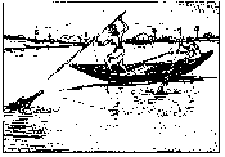This species inhabits the Ganges, Brahmaputra and Meghna rivers of India, Bangladesh, Nepal and Bhutan. The local name is 'SUSU'.
Description:
 The Ganges River Dolphin has a long beak which thickens toward the tip, revealing the large teeth; the mouth-line curves upward. The body is stocky with a rounded
belly, the flippers are large and paddle-shaped, and there is a low triangular hump in place of a 'true' dorsal. Ganges River Dolphins are grey-brown in colour, sometimes with a pinkish belly, and measure between 1.5 and 2.5m in length, weighing a maximum
of 90kg.
The Ganges River Dolphin has a long beak which thickens toward the tip, revealing the large teeth; the mouth-line curves upward. The body is stocky with a rounded
belly, the flippers are large and paddle-shaped, and there is a low triangular hump in place of a 'true' dorsal. Ganges River Dolphins are grey-brown in colour, sometimes with a pinkish belly, and measure between 1.5 and 2.5m in length, weighing a maximum
of 90kg.
They are spotted in the Upper Ganges near Ganmukteswar, 80 km from Delhi. Around Amavasi Day when mass bathing takes place in the river, they are not visible. Food & Feeding:
These dolphins take fish, squid, crustaceans and turtles. They have also been known to chase and attack waterfowl. Indian skimmer, Spoon bill and dolphin feed on the same kind of fish.
Behaviour:
Ganges River Dolphins travel either as couples or individuals. Since these dolphins do not have a crystalline eye lens they are effectively blind; all they can do is detect
the direction and intensity of light. Navigation, therefore, is entirely by a sophisticated echolocation system. This blindness is one of the reasons why these dolphins swim on one side underwater, with one flipper trailing in the muddy riverbed. The physical
touch gives the dolphins important information about their surroundings and helps them find food.
Longevity:Unknown.
Estimated Current Population:
Approximately 2,000 - 3,000 individuals. Endangered. The Influence of Man: The Ganges River Dolphins live in one of the world's most densely populated areas - almost a tenth
of the world's population lives within the Ganges drainage area. Rivers are constantly being dammed for electrical and irrigation purposes, and boat traffic, fishing and chemical pollution are increasing. Many dolphins are taken annually both accidentally
and
Deliberately:
Fishermen are known to kill dolphins for their oil near Gorakhpur.
Under the Ganga Action Plan, WWF is taking measures to protect the Gangetic River Dolphin whose numbers indicate the pollution levels of the river. One of the measures taken
is educating the locals including the politicians about the need to save the dolphin. Unlike the marine dolphins river dolphins cannot be tamed.
Dr. Sandeep Kumar Behera, Sr. Programme Officer, WWF-India is in charge of the Ganges River Dolphin programme.